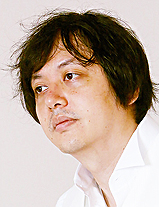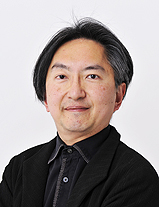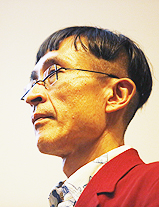Artificial Intelligence Art and Aesthetics Research Group (AIAARG)
-
The 25th AI Art & Aesthetics Research Meeting
“What If AI Composed for Mr. S? -1”
- Aug 24 (Sat) 14:00-
- Across from The Container, the venue for the AI Art & Aesthetics Exhibition
Non-freedom of expression occurs frequently. The bashing our research group received in January of this year, mainly from academics, for its attempt to invite Mr. J was short-sighted and unfair. The AI Art & Aesthetics Exhibition “What If AI Composed for Mr. S?,” currently being held at The Container in Nakameguro, Tokyo, is still available for viewing.
The 25th AI Art & Aesthetics Research Meeting will be held at the Oasis Hall at the Immanuel Nakameguro Christ Church, across from the exhibition venue on Saturday, August 24, as a related event of the AI Art & Aesthetics Exhibition. The event will take place at 2pm.
Guest panelists are Hidefumi Ohmura, Researcher of Music Information Science / Mood Engineering, Assistant Professor of Department of Information Sciences, Tokyo University of Science, and Morihide Katayama, Political Scientist, Music critic, Professor of Faculty of Law, Keio University.
Please come and participate.
Outline
-
[Title]
- The 25th AI Art & Aesthetics Research Meeting “What If AI Composed for Mr. S? -1”
-
[Date]
- August 24 (Sat), 2019. 14:00-17:30 (door open 13:30)
* Followed by a social gathering together with the panelists at a near-by restaurant
- August 24 (Sat), 2019. 14:00-17:30 (door open 13:30)
-
[Venue]
- Oasis Hall, Immanuel Nakameguro Christ Church (1-12-7 Kamimeguro Maguro-ku Tokyo)
https://www.igmnakameguro.com/english/
- Oasis Hall, Immanuel Nakameguro Christ Church (1-12-7 Kamimeguro Maguro-ku Tokyo)
-
[Lecture]
- Hidefumi Ohmura (Researcher of Music Information Science / Mood Engineering. Assistant Professor of Department of Information Sciences, Tokyo University of Science.)
Morihide Katayama (Political Scientist. Music Critic. Professor of Faculty of Law, Keio University.)
Hideki Nakazawa (Artist. Representative of AIAARG.)
* After the lecture, we will set a time for a general discussion.
* We welcome the filming and live-tweeting and broadcasting of lectures and discussions. We will release the recorded video at a later date.
* Language: Japanese
- Hidefumi Ohmura (Researcher of Music Information Science / Mood Engineering. Assistant Professor of Department of Information Sciences, Tokyo University of Science.)
-
[Entrance Fee]
-
[Organizer]
- Artificial Intelligence Art and Aesthetics Research Group (AIAARG)
Lecture
“Emotion and Creativity in Music from an Information Science Perspective”
Hidefumi Ohmura (Researcher of Music Information Science / Mood Engineering. Assistant Professor of Department of Information Sciences at Tokyo University of Science.)-
- The music is nothing more than a temporal structure and abstract expression of sound. Nonetheless, it is a mysterious medium that exists in every culture and influences human emotions. Furthermore, many humans, of all ages and genders, have the musical creativity to improvise whistling and humming. Attempts to get computers to do creative compositions/arrangements automatically began in 1959. It is interesting to note that this was about the same time as the Dartmouth Conference at which artificial intelligence research was established. In this lecture, I will examine emotion and creativity in music from the point of view of information science, focusing on not only the sound information of music but also information other than sound, while taking an overview of automatic composing leading to artificial intelligence.
- * Hidefumi Ohmura, assistant professor at Tokyo University of Science, who studies automatic generation of emotion-based melodies and other topics, is one of the co-translators of David Cope's “Computer Models of Musical Creativity.” (* by AIAARG)
https://sites.google.com/site/hidefumiohmura/ 
“Religion, Kitsch, and Symphony. Or in Order to Be Moved, There Needs a Mediocre Pattern”
Morihide Katayama (Political Scientist. Music Critic. Professor of Faculty of Law, Keio University.)-
- In the history of classical music, 19th-century Romantic music is often positioned as an “alternative to Christian worship.” Especially applicable to such a position would be the stream of the magnificent symphonies that finds its apex in Bruckner and Mahler. Magnificent symphonies are naturally better performed in huge concert halls with large audiences and emotionally moving performances. It is exactly the secularization of church worship, a new form of religion in a godless age, where the dream of salvation through faith is transformed into a momentary dream of euphoria through beauty, where excitement and tears will be indispensable. It can be said that the pattern that leads to euphoria, excitement and tears has been built up by multiplying a long time and various backgrounds. Repetition of patterns. There will inevitably be fake characteristics invited there as well. However, since a pattern sets up a “circuit of conditioned reflexes of an emotion,” it also means that people can only be moved by kitsch. Classical style music after the 20th century, from Hollywood to the Soviet Union, would have been perceived as useful precisely in its kitschiness. Moreover, the symphony is a form of music that can give a world view, like religion, animation, or video games. I regard the symphony as having reached an impasse in Japan after the Heisei era, along the lines of the transition from Shoko Asahara to Mamoru Samuragochi. I would like to talk about that.
- * Morihide Katayama, who shows off his encyclopedic knowledge on NHK-FM's “Classical Labyrinth,” awarded Hidekazu Yoshida Prize and Suntory Prize for Social Sciences and Humanities for his books “Study of Modern Social Phenomena of Sound Disks” and “Natural History of Sound Discs,” and Shiba Ryotaro Prize for “Unfinished Fascism.” Specializes in the history of political thought. Professor of Keio University. (* by AIAARG)
https://ja.wikipedia.org/wiki/%E7%89%87%E5%B1%B1%E6%9D%9C%E7%A7%80 
“About the AI Art & Aesthetics Exhibition 'What If AI Composed for Mr. S?' -1”
Hideki Nakazawa (Artist. Representative of AIAARG.)-
- That the series of scandals woven by Mamoru Samuragochi and Takashi Niigaki, which no one now wishes to touch, has a depth comparable to that of Tsuguharu Fujita, the painter who painted war pictures, is imprinted in each note of “Symphony No. 1,” which is still banned by JASRAC. The catalogue for this exhibition contains a manuscript co-authored by Mika Kusakari and Nakazawa, “What If AI Composed for Mr. S?,” which has over 11,000 characters in Japanese. The text begins with the Lassen problem and points out the impact of being a true postmodernist. Then, it elucidates the principle of artistic supremacy (art for art's sake) that is evident in the instructions given by Samuragochi to Niigaki, leading to a discussion of “human aesthetics / machine art” and “machine aesthetics / machine art.” The authors can't help but feel a new symphony that encapsulates all of these things buzzing in a lively way in their minds.
- * The artist name Hideki Nakazawa irregularly written in angular Japanese syllabary is used from the time of medical school enrollment. After Silly CG, Methodicist Manifesto, New-Methodicist Manifesto, Manifesto of Artificial Intelligence Art and Aesthetics. Bitmap 3D Patent. He has written “Art History: Japan 1945-2014.” Former juror of The Japan Media Arts Festival.
https://www.aloalo.co.jp/nakazawa/ 
Image
Link
- Announcement via email (Japanese)
https://www.aloalo.co.jp/nakazawa/2019/0804a_j.html - Event page on Facebook (Japanese)
https://www.facebook.com/events/880039772366369/
(This page was translated by Mari Fujii & Masami Fujii.)